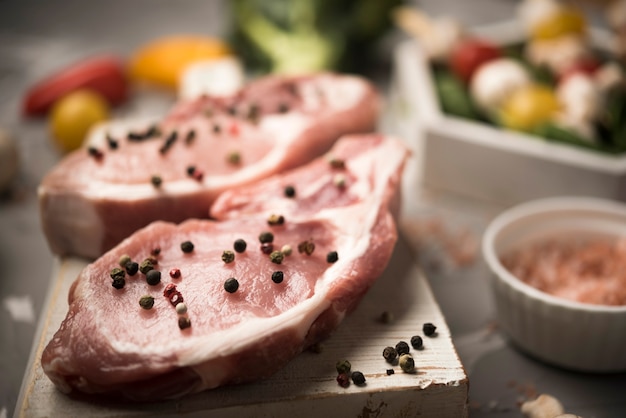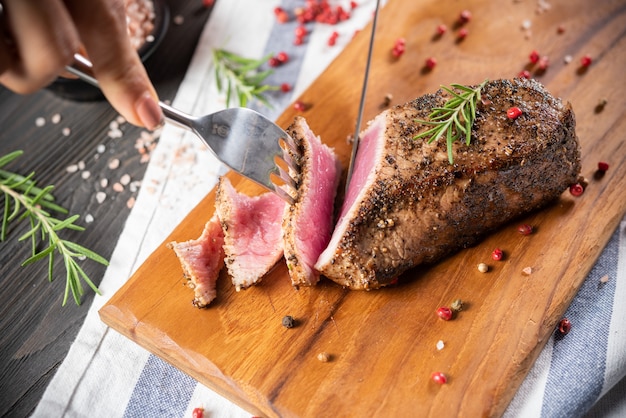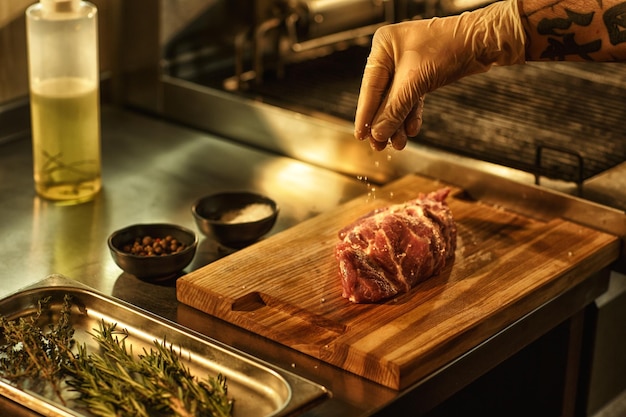You've got a craving for juicy, flavourful pork chops, right? Who doesn't love a good pork chop? But before you jump into the kitchen, let's talk about temperature. See, the secret to a truly delicious pork chop lies in knowing exactly when it's cooked to perfection. Get it wrong, and you're left with a dry, tough, and frankly, disappointing meal. But get it right, and you'll be rewarded with juicy, tender pork chops that'll have you savoring every bite.
As someone who has spent years in the kitchen, I've seen my fair share of pork chop disasters. Overcooked, undercooked, you name it, I've done it. But through trial and error (and a lot of help from my trusty kitchen thermometer), I've learned how to cook pork chops to perfection every time. So, grab a cuppa, settle in, and let me share my secrets with you.
(Part 1) The Basics: Understanding pork chop cooking Temperatures

First things first, we need to talk safety. The Food Standards Agency (FSA) recommends cooking pork chops to an internal temperature of 71°C (160°F) to ensure they're safe to eat. This is all about killing off any harmful bacteria that might be lurking. Now, that's the minimum, but we want to go a little further to achieve the most delicious results.
1.1 The "Safe Zone" for Pork Chops
The "safe zone" for pork chops is between 71°C (160°F) and 74°C (165°F). At this temperature, the pork is fully cooked and safe to eat, while still retaining some moisture and tenderness. This is where you want to be for a safe and enjoyable meal.
1.2 The "Perfect" Temperature for Tender and juicy pork
But if you want to really impress your taste buds, aim for 63°C (145°F). This is the "perfect" temperature for a juicy and tender pork chop. The trick is to let the pork rest for 5-10 minutes after cooking. This gives the juices a chance to redistribute throughout the meat, resulting in an incredibly juicy and flavorful experience.
(Part 2) Cooking Methods and Their Ideal Temperatures

Now, let's talk about different cooking methods and how they affect the desired temperature. Each method has its own nuances and requires a slightly different approach to achieve the perfect outcome.
2.1 Pan-Frying: The Classic Method
Pan-frying is a classic method for cooking pork chops, and it's a great way to achieve a crispy exterior and a juicy interior. Aim for an internal temperature of 63°C (145°F) for medium-rare, and 71°C (160°F) for medium. You can achieve this by cooking over medium heat for about 4-6 minutes per side.
Here's a tip: Don't overcrowd your pan! Give each pork chop plenty of space to brown properly. If you need to cook in batches, that's perfectly fine.
2.2 Grilling: Adding Smoky Flavour
Grilling adds a delicious smoky flavour to your pork chops, making them perfect for a barbecue or outdoor meal. Aim for the same internal temperatures as pan-frying, 63°C (145°F) for medium-rare and 71°C (160°F) for medium. It's best to grill over medium-high heat for about 5-7 minutes per side, flipping once.
Keep an eye on your grill to ensure it doesn't get too hot, as this can lead to burning. A little bit of smoke is good, but too much can overpower the flavour of the pork.
2.3 Baking: A Less Hands-On Approach
Baking is a good option if you're looking for a less hands-on approach. Preheat your oven to 190°C (375°F) and cook for 20-25 minutes, or until the internal temperature reaches 63°C (145°F) for medium-rare or 71°C (160°F) for medium. Covering the pork chops with foil for the first 15 minutes helps to ensure even cooking.
You can also add vegetables to the baking dish for a complete meal. For instance, potatoes and carrots make a delicious combination with pork chops. Just remember to check the internal temperature of the pork chops to ensure they're cooked through.
(Part 3) The Kitchen Thermometer: Your Essential Tool

Let's be honest, most of us aren't culinary wizards who can magically know when a pork chop is perfectly cooked just by looking at it. That's where a kitchen thermometer comes in. It's your secret weapon, taking the guesswork out of cooking and ensuring you get the perfect level of doneness every time.
It's so simple to use: Just insert the probe into the thickest part of the pork chop, avoiding any bone, and wait for a few seconds. The thermometer will display the internal temperature, and you'll know exactly where you stand.
3.1 Digital vs Analog: Which Thermometer is Right for You?
There are two main types of thermometers: digital and analog. Digital thermometers are known for their accuracy and ease of reading, while analog thermometers are typically more affordable and compact. Choose the one that best suits your needs and budget. But, no matter what you choose, make sure it's a reliable thermometer.
(Part 4) The Pork Chop's Colour: A Visual Cue
While a thermometer is the most reliable way to determine doneness, visual cues can also be helpful. However, it's important to understand the limitations of relying solely on colour.
4.1 The "Pinkness" Myth
One of the biggest misconceptions about pork is that it must be completely white to be fully cooked. This is simply not true! A pork chop that is still pink doesn't necessarily mean it's undercooked. The pink colour comes from a pigment called myoglobin, which is present in all meat. It's the internal temperature, not the colour, that matters.
4.2 Looking for "Doneness" Beyond Colour
Instead of solely focusing on colour, look for other visual cues. For example, a medium-rare pork chop will have a slightly pink center, while a medium pork chop will be mostly white or slightly pink in the center. A well-done pork chop will be completely white throughout.
Remember, colour is just one factor, and it's important to use a thermometer to confirm that your pork chops are cooked to a safe internal temperature.
(Part 5) Understanding Different Levels of Doneness
Let's dive into the different levels of doneness and how they impact the texture and flavour of your pork chops.
5.1 Rare: Not Recommended for Pork
Rare pork chops have a very pink center, and the meat will be soft and juicy. However, the FSA advises against eating rare pork due to the risk of foodborne illness. For your safety, stick to cooking your pork chops to at least 71°C (160°F).
5.2 Medium-Rare: The Most Popular Choice
Medium-rare pork chops have a slightly pink center and are slightly firmer than rare. They're still tender and juicy, and have a nice balance of flavour. This is the most popular level of doneness for pork chops, and it's what I usually go for.
5.3 Medium: A Firm and Slightly Drier Option
Medium pork chops have a mostly white center with a slight pink tinge. They're firm and slightly drier than medium-rare, but still juicy and flavorful. This is a good option if you prefer your pork chops a little less pink.
5.4 Well-Done: Cooked Through and Through
Well-done pork chops are completely white throughout and are the firmest and driest. They're not for everyone, but if you prefer your pork cooked through and through, this is the level for you.
(Part 6) Resting: An Essential Step for Juicy Pork
You've cooked your pork chops to perfection, but there's one more crucial step: resting. Resting is essential for ensuring that your pork chops are as juicy and tender as possible. It allows the juices to redistribute throughout the meat, resulting in a more flavorful and succulent experience.
Cover the cooked pork chops with foil and let them rest for 5-10 minutes before slicing and serving. Don't be tempted to slice them immediately; give them a chance to relax and soak in their own goodness.
(Part 7) Serving Suggestions: Elevating Your Pork Chop Meal
Your pork chops are cooked to perfection, rested, and ready to be enjoyed. But now what? How can you create a truly amazing meal? Let's explore some delicious side dish and sauce ideas.
7.1 side dishes for Pork Chops
Pork chops pair beautifully with a range of side dishes. Here are a few suggestions to round out your meal:
- mashed potatoes: A classic comfort food that complements the savory flavour of pork chops.
- Roasted vegetables: Adding roasted vegetables like asparagus, carrots, or broccoli provides a beautiful colour contrast and a boost of nutrients.
- A simple green salad: A light and refreshing side dish to balance the richness of the pork chops.
- Couscous or rice: These grains provide a light and fluffy accompaniment to the pork chops.
- Potato wedges: For a heartier side dish, try crispy potato wedges.
- Apple sauce: A sweet and tangy sauce that pairs perfectly with pork chops.
7.2 Sauces to Elevate Your Pork Chop Meal
A delicious sauce can really elevate a pork chop meal. Try these options to add another layer of flavour:
- Apple cider sauce: A sweet and tangy sauce made with apple cider, brown sugar, and spices.
- Mushroom sauce: A rich and savory sauce made with mushrooms, onions, and cream.
- Mustard sauce: A tangy and spicy sauce made with mustard, honey, and vinegar.
- Peppercorn sauce: A bold and flavorful sauce made with peppercorns, cream, and brandy.
(Part 8) Tips for Mastering the Perfect Pork Chop
Now, let's wrap up with some tips and tricks to help you cook perfect pork chops every time.
8.1 choosing the right cut
Not all pork chops are created equal. When selecting your pork chops, look for cuts that are about 1-1.5 inches thick. These cuts are ideal for achieving a juicy and tender result. Avoid thin chops, as they can dry out easily.
8.2 Seasoning with Love
Don't skimp on the seasoning! Pork chops love a good flavour boost. Salt and pepper are essential, but don't be afraid to experiment with herbs and spices. Rosemary, thyme, garlic, and paprika all pair beautifully with pork. You can rub the seasoning directly onto the pork chop, or create a marinade for extra flavour.
8.3 Resting is Key
We've already discussed the importance of resting your pork chops after cooking. This is a crucial step to ensure juicy and tender results. So don't skip this step!
8.4 Don't Overcook!
overcooked pork chops are a culinary crime! Always use a thermometer to ensure your pork chops are cooked to the desired level of doneness. Remember, a little bit of pink is perfectly okay and actually indicates a juicier, more flavorful chop.
8.5 Practice Makes Perfect
Like any culinary skill, cooking the perfect pork chop takes practice. Don't be discouraged if your first few attempts don't turn out perfectly. Keep experimenting, keep learning, and you'll eventually master the art of cooking delicious pork chops.
FAQs
1. Can you freeze pork chops?
Yes, you can freeze pork chops for up to 3 months. To freeze, wrap them individually in plastic wrap or freezer paper, and then place them in a freezer-safe bag. When ready to use, thaw the pork chops in the refrigerator overnight.
2. How do you know if a pork chop is done?
The best way to tell if a pork chop is done is to use a kitchen thermometer. The internal temperature should reach 71°C (160°F) for safe consumption. You can also use visual cues, like checking for a mostly white center with a slight pink tinge for medium, or a completely white center for well-done. However, relying solely on colour can be misleading, so always confirm with a thermometer.
3. What happens if you overcook a pork chop?
If you overcook a pork chop, it will become dry and tough. The juices will be cooked out, leaving you with a less-than-appealing meal. To avoid overcooking, use a thermometer and cook to the desired level of doneness.
4. Can you cook pork chops to rare?
While it's technically possible to cook pork chops to rare, the FSA advises against it. There is a higher risk of foodborne illness when pork is undercooked. It's always best to cook pork chops to at least 71°C (160°F) to ensure they're safe to eat.
5. What's the best way to cook a pork chop?
The best way to cook a pork chop depends on your personal preferences. Some people prefer pan-frying, while others prefer grilling or baking. Ultimately, it's up to you to choose the method you enjoy most. Just make sure to cook the pork chop to the desired internal temperature, and rest it properly before serving.
Everyone is watching

How to Cook Frozen Lobster Tails Perfectly: A Step-by-Step Guide
RecipesLobster. Just the word conjures up images of lavish meals, special occasions, and a taste of luxury. But let's...

Pigs in a Blanket Cooking Time: How Long to Bake for Perfect Results
RecipesAh, pigs in a blanket. Just the name conjures up images of those delightful little parcels of crispy pastry en...

Pork Fillet Cooking Time: How Long to Cook It Perfectly
RecipesPork fillet, or tenderloin as it's sometimes called, is a real favourite in our house. It's so versatile, and...

The Ultimate Guide to Cooking Delicious Frankfurters
RecipesLet's face it, we all love a good frankfurter. It's a classic, simple, and always satisfying. But let's be rea...

Wolf Meat Recipes: A Guide to Cooking Wild Game
RecipesLet's be honest, you don't see wolf meat at your local butcher shop every day. It's a bit of a wild card, but ...
